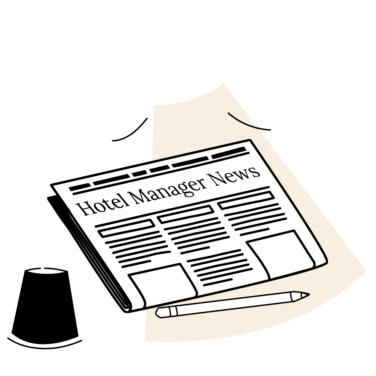As a hotel manager, it's important to be aware of key performance indicators (KPIs) and understand what they mean. This will help you track your hotel's performance and identify areas for improvement.
In this post, I'll explain 15 common KPIs and what they measure.
What Are KPIs and Why Are They Important?
Key Performance Indicators (KPIs) are important metrics that hotel managers use to measure the performance of their hotel. Measuring these metrics enables managers to track progress over time, and make changes where necessary to improve their hotel's performance.
There are many different KPIs that can be tracked, but the 15 most common ones are listed below. These KPIs can be used to measure a hotel's performance in the following areas:
- Revenue
- Occupancy
- Food and Beverage Sales
etc.
Common KPIs in the Hotel Industry
There are a number of key performance indicators (KPIs) that hotel managers use to measure the success of their hotel. In this article, we'll outline 15 of the most common KPIs and what they mean for hotel managers.
Some of the most common KPIs in the hotel industry include: occupancy rate, average room rate, RevPAR (revenue per available room), food and beverage revenue, payroll costs as a percentage of revenue, and ADR (average daily rate).
Each KPI provides valuable insights into different aspects of hotel performance. occupancy rate, for example, tells you how full your rooms are on average, while RevPAR tells you how much revenue your rooms are generating.
By understanding and tracking these KPIs, hotel managers can make informed decisions about how to improve their hotel's performance.
Occupancy Rate
One of the most important KPIs for measuring hotel performance is occupancy rate. This metric tells you how many rooms are booked on a given night. It's usually expressed as a percentage, and higher numbers are better.
There are a few different ways to calculate occupancy rate. The most common method is to divide the number of rooms sold by the number of rooms available. Another way is to divide the total number of guests by the total number of room nights sold.
No matter how you calculate it, occupancy rate is a key measure of a hotel's success. If your occupancy rate is low, you may need to reevaluate your pricing strategy or marketing efforts.
Average Daily Rate
One of the most important KPIs for measuring hotel performance is average daily rate (ADR). This tells you how much your guests are spending on average per day, and is a good indicator of how healthy your business is. If ADR starts to drop, it could mean that you're not charging enough for your rooms, or that guests are choosing to stay elsewhere. On the other hand, if ADR increases, it means you're getting more for your rooms and you can start to think about increasing your prices.
Revenue per Available Room (RevPAR)
One of the most important KPIs for hotel managers is revenue per available room, or RevPAR. This metric takes into account the average daily rate of a room (ADR) and the occupancy rate to give you an idea of how much money your hotel is making per day.
A high RevPAR means that your hotel is performing well and filling up its rooms at a high price. A low RevPAR, on the other hand, means that you may need to consider lowering your prices or finding ways to increase occupancy.
Length of Stay (LOS)
One of the most important KPIs for hotel managers is Length of Stay (LOS), which is the average amount of time a guest stays at your hotel. This metric can tell you a lot about how well your hotel is performing, and whether you're attracting the right guests.
If LOS is decreasing, it means that guests are not staying as long as they used to, which could be a sign that there's something wrong with your hotel or that you're not offering what guests want. on the other hand, if LOS is increasing, it means that guests are staying longer than they used to, which is a good sign that you're doing something right and that guests are enjoying their stay.
Other Hotel Management KPIs
Above, I covered some of the most important KPIs that almost every hotel operation will use at some point to measure performance.
Below, I'll cover some additional KPIs according to the department that they measure.
Housekeeping Department KPIs
One of the most important departments in any hotel is the housekeeping department. After all, it's their job to keep the rooms clean and tidy! As a hotel manager, it's important to be familiar with the key performance indicators (KPIs) that relate to this department.
Here are some of the most important HKD KPIs:
- Number of rooms cleaned per day/hour
- Percentage of occupied rooms that have been serviced
- Percentage of lost and found items returned to guests
- Percentage of complaints about housekeeping services
Maintenance Department KPIs
There are a few key hotel maintenance KPIs that hotel managers should be aware of. These are metrics that will help you evaluate the effectiveness of your team's work and identify areas for improvement.
Some of the most important maintenance department KPIs include:
- Percentage of rooms occupied vs. number of available rooms
- Percentage of rooms that were cleaned on time
- Number of guest complaints about housekeeping or maintenance
- Number of pieces of furniture and equipment repaired or replaced
Sales and Marketing KPIs
Sales and marketing KPIs are essential for hotel managers to measure the performance of their marketing campaigns and identify areas where they can improve. Some of the most commonly used KPIs in this area include:
- Website visits
- Web conversion rates
- Email open rates
- Social media followers
By tracking these metrics, hotel managers can see whether their marketing efforts are generating results and identify any areas that need improvement. For example, if website visits are down compared to last year, it might be time to rethink the website's design or consider running a new marketing campaign.
Human Resources KPIs
One of the key areas that hotel managers need to track is how their team is performing. This includes metrics such as employee satisfaction, staff turnover rates, and training and development spending.
Here are four HR KPIs that you should be tracking:
- Employee satisfaction – This measures how happy your employees are with their current job. Tracking this metric can help you understand areas where your team may be unhappy, and identify ways to improve their satisfaction levels.
- Staff turnover rate – This measures the percentage of employees who leave your organization within a given time period. Tracking this metric can help you understand how well you're retaining your staff, and identify any areas that may need improvement.
- Training and development spending – This measures how much money you're spending on training and development programs for your employees. Tracking this metric can help you understand if you're investing enough in your team's development, and identify areas where you may need to invest more.
- Employee productivity – This measures the average output of each employee. Tracking this metric can help you understand which employees are most productive, and identify ways to help others achieve similar levels of productivity
Conclusion: How to Use KPIs to Improve Hotel Performance
Now that you understand the basics of hotel KPIs, it's time to put them to use and improve your hotel's performance. Remember, each KPI should be tailored to your specific hotel and the goals you want to achieve.
Here are a few tips for using KPIs to improve hotel performance:
1. Track your KPIs regularly and analyze the data to see what's working and what needs improvement. Many hotel operations use data from their hotel management software, motel software, front desk software, and other tools in their tech stack.
2. Use KPIs to set targets and measure progress over time.
3. Make changes based on your findings and track the results to see if they're positive or negative.
4. Use KPIs to identify areas of weakness and strength so you can focus your efforts where they're needed most.
5. Communicate results and progress to staff and guests so everyone is aware of how the hotel is doing.
6. Keep an open mind and be prepared to make changes if necessary - hotel performance is always evolving so you need to be adaptable.
Conclusion
There are many different KPIs that can be used to measure hotel performance. However, the KPIs listed in this guide are some of the most important and commonly used ones.
Each of these KPIs provides important information about different aspects of hotel performance. By understanding what they mean and how to track them, hotel managers can make informed decisions that will help improve their hotel's performance.



